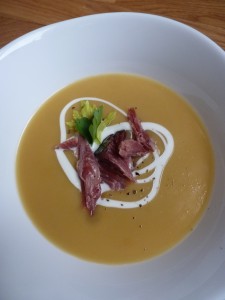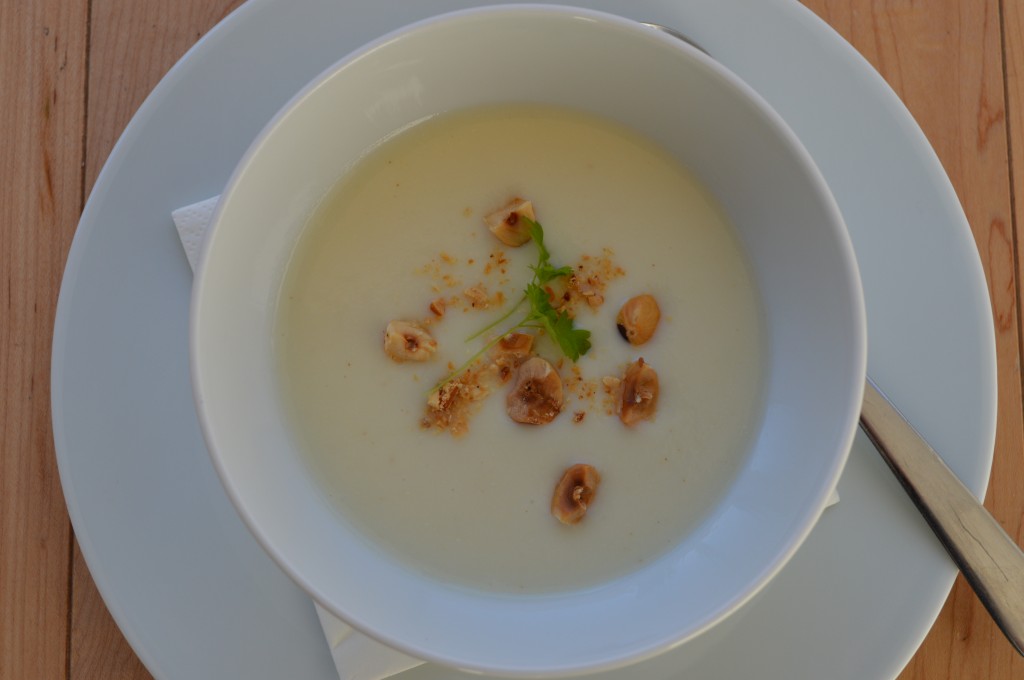 There is something medieval about soup. It is often made from bones. It takes time to prepare, and to eat. Soup is slow and simple and primordial and the opposite of modern.
There is something medieval about soup. It is often made from bones. It takes time to prepare, and to eat. Soup is slow and simple and primordial and the opposite of modern.
I consider the promulgation of soup a personal mission. Most of the formal meals that I prepare for friends or at work include a soup course. Burns supper, for instance, begins with Scotch broth, Thanksgiving with squash soup, Viennese dinners with pancake soup.
Types of Soup
This is the kind of rant I usually relegate to the footnotes of a post, but I want to talk about soup classification. In culinary school our standard text was called Professional Cooking for Canadian Chefs (PCCC). I learned a lot from this book, but some parts of it are seriously whack. One of the most annoying things in PCCC is its classification of soups. There are, it says, four types of soup: clear, thick, international, and specialty. Isn’t that ridiculous? Gumbo (a thick soup) was classified as an “international” soup, because it had a specific regional origin (Louisiana). Gazpacho (a thick soup with a specific regional origin) was classified as a specialty soup, because it is served cold. Ridiculous. It’s like saying there are four types of cars: red, blue, fast, and Italian.
So, let me correct the matter and say that there are two types of soup: clear and thick. Many of those soups have specific regional origins. A few of them are served cold. But they are all either clear or thick.
Clear Soups
 Clear soups are made with transparent stock or broth, through which is distributed various garnishes such as vegetables, meat, and starches. Chicken noodle soup is a clear soup.
Clear soups are made with transparent stock or broth, through which is distributed various garnishes such as vegetables, meat, and starches. Chicken noodle soup is a clear soup.
The principle aesthetic consideration when preparing clear soups is the colour and clarity of the stock. Adherence to these basic stock-making principles will result in a clear, flavourful stock with an appetizing colour.
Converting good stock into a soup can be as simple as adding some chopped vegetables and leftover meat. I typically lightly sauté my vegetables in butter before adding the stock. This is strictly for flavour. Be sure to use a scant amount of fat to sauté your vegetables. It’s nice to have a few spots of fat floating on top of a clear soup (the French call these spots “eyes”), but you don’t want so much that it forms a mat of grease.
If the clear soup will contain a starch such as pasta or rice, cook the starch in a separate pot of water. These garnishes leach starch into the liquid as they cook, so they would cloud your soup. Think about what water looks like after you’ve boiled pasta in it.
Thick Soups
When the liquid body of the soup is opaque and viscous enough to coat the diner’s spoon we describe the soup as thick. Thick soups can get their viscosity in a number of ways.
Purée Soups. Purée soups experienced a minor renaissance about ten years ago when a marketing genius started selling ready-made butternut squash soup. Before that, most people in our part of the world only knew of stodgy “cream soups” like cream of mushroom and cream of potato. I know that’s a pretty sweeping generalization, but this is a blog not an encyclopedia and I get to write things like that.
The most important thing to know about purée soups is that they must contain some sort of starch. Broccoli, for instance, contains little starch, and will not make a cohesive, voluptuous purée without the help of a starchy companion like potato.
I would like to discourage three common practices when it comes to purée soups.
The first is the idea that you need stock to make soup. This is a lie invented by classical French cuisine. Stock is helpful (but not essential) in clear soups, but more or less useless for purée soups. For starters, the full body of a rich stock is completely lost in the starchy mass of the purée. Also I think the goal of a purée soup should be to taste perfectly like the ingredient it is made from. If I make a potato soup, I don’t really want it to taste like chicken and mirepoix. You can make very, very flavourful purée soups using only water.
The second is born from the idea that a soup or sauce has to simmer for several hours to develop flavour. This isn’t true. In fact, vegetables have the most flavour when they are just, just cooked. After this the flavour wanes. Vegetables should only be cooked to the point of complete tenderness before being puréed.
Finally is the idea that you must finish a purée soup with cream. There is a time and a place for cream in soups, but it has a tendency to mute other flavours. In some cases it also kills the colour. I like to use cream with potato soups and mushroom soups. I would never add cream to a squash soup, as it would turn the vibrant orange to a muted yellow, and muddle the natural, sweet flavour of the vegetable.
The way to really distinguish a purée soup is to make it as smooth and velvety as possible. Nothing will get vegetable mash as smooth as an upright blender like a Vitamix. Food processors, even powerful commercial varieties like the Robot Coup, and immersion blenders just don’t circulate like an upright blender. Start blending the soup and forget about it for maybe five minutes, then run the soup through a chinois.
Purée soups should not be stodgy; a spoon dragged along the surface shouldn’t leave a trace.
Purée Soup Case Study: Squash and Apple Soup

This is a magic soup of subtle architecture that perfectly bridges savoury, sweet, and tart.
Sautée sliced onions and garlic in butter until the onions are becoming translucent. Add cubed squash and apple and sauté briefly. Cover with cold water. Bring to a simmer. As soon as the squash is tender, transfer the soup to a blender.
Season. Don’t feel shy about adding a bit of sugar to reinforce the natural sweetness of the squash.
Garnish this soup with the redolent wonder that is Styrian pumpkin seed oil, which I wrote about here. Other appropriate garnishes: heavy cream, roasted pumpkin seeds.
Roux-Thickened Soups. Roux is the traditional way to thicken several classic soups, including chowder and gumbo, but it has fallen from favour in recent decades. In fact, some of the chefs I have worked for have explicitly banned roux from their kitchens. There are a few reasons for this. First is the ever increasing phenomenon of gluten sensitivity. More generally, roux is seen as stodgy.
I love roux. I always have butter and flour in my kitchen. It tastes good. I use it in mac and cheese and corn chowder and even tourtière.
If for some reason you can’t use a roux in a chowder, you can make the soup as if it were a clear soup, then separate a portion, puré it, and mix it back with the rest of the soup.
A Quick Note on Cold Soups before we go
I think the two most common cold soups are tomato (“gazpacho”) and cucumber. Many have tried these and decided they’re gross and then sworn off cold soup for the rest of their lives. A better gateway into cold soups is the starchy varieties like potato and leek (“Vichysoisse”) and those containing fruit (the squash and apple soup described above).
My favourite cold soup is parsnip and pear:
In conclusion, I’ll reiterate that soup is the very essence of frugality and comfort. Let it be a part of your life.